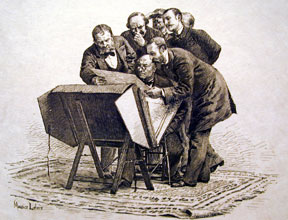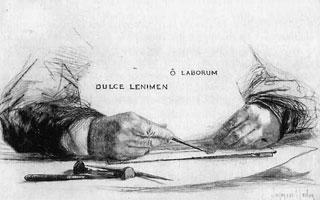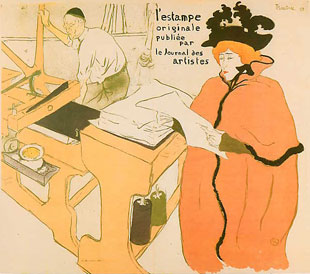A
Glossary of
Printmaking Terms

|
|
A
|
 |
An original print is specifically a work printed from a matrix executed by the artist himself, as opposed to reproductions and copies.
Classically, there are three basic types of printmaking techniques:
Aquatint: an etching technique that produces zones of textured tone, or grain, on the plate; negative graining is most commonly done by dusting the plate with resin that adheres when heated; the plate is then bitten with an acid solution (mordant), which attacks the metal in those areas left uncovered by the resin grain, giving a characteristic reticulated effect; the resin is lastly removed with a solvent, and the plate may be printed. In the opposite technique of positive graining, the plate is covered with a dilute ground, dusted with water-receptive particles such as sugar, and then plunged into cold water; when put into the acid bath, the mordant bites through to the metal at those points of contact with the particles, leaving fine stippled patterns. There are also examples of bitten tone using acid droplets or wash directly on the plate.
Bon à tirer (or "Ready to print"): an exemplary trial proof that serves as reference for the subsequent printing of an edition; the "bon à tirer" is often signed by the artist or the editor, and regularly annotated.
 Drypoint: an
engraving technique using a sharp steel needle to incise the bare
metal plate; yet unlike burin engraving or etching, drypoint does
not remove metal from the plate, but rather raises a fine burr
along the incised line, something like the crest of a wave, which
retains a good amount of ink that is squeezed out under the press,
printing rich velvety blacks that are quite characteristic; burr
however tends to wear down rapidly under pressure, thus typifying
early impressions, and is therefore highly prized by discerning
collectors.
Drypoint: an
engraving technique using a sharp steel needle to incise the bare
metal plate; yet unlike burin engraving or etching, drypoint does
not remove metal from the plate, but rather raises a fine burr
along the incised line, something like the crest of a wave, which
retains a good amount of ink that is squeezed out under the press,
printing rich velvety blacks that are quite characteristic; burr
however tends to wear down rapidly under pressure, thus typifying
early impressions, and is therefore highly prized by discerning
collectors.
"O Laborum
Dulce Lenimen" by Francis Seymour Haden,
a drypoint engraving of the artist at work
(with various tools in the foreground)
Edition: a commercial series of impressions that is most often homogeneous in terms of paper, printing style, numbering, and signature. Signing and numbering prints was not widespread until the late 19th century however, before which artists only occasionally signed presentation pieces, offered to friends or patrons.
Engraving: a general term of intaglio printmaking, covering a variety of manual techniques that utilise cutting tools (burin, drypoint, roulette, etc.) to remove fillets or flecks of metal from those areas intended to hold ink during printing; given its mechanical rather than chemical nature (no acid is involved), engravings are characterised by a certain sharpness of line.
Etching: an intaglio process using acid to eat away those areas of the plate that are to hold ink; it comprises three basic steps: 1) preparing the metal plate, covered with an acid-resistant ground*; 2) drawing through the ground with a pointed instrument to reveal the bare metal; and 3) biting the plate with a mordant, the acid dissolving the exposed metal to the degree desired; once the remaining ground removed with a solvent, the plate is inked and printed like an engraving.
Glass Prints: a photographic technique by which a glass plate is coated with an opaque layer of white lead and then worked with a brush or a point to reveal transparencies; once dry, the plate is laid over photosensitive paper, which is exposed, developed, and fixed as required.
Ground: an acid-resistant coating, like a sort of varnish, which is applied to an etching plate in order to mask those areas that are to remain unbitten, and through which the artist traces the lines that make up the drawing; soft-ground etching is done with a ground that remains tacky, so that when the artist puts a sheet of paper over the plate and draws on it, the ground adheres on the reverse side of the drawing, and is taken off when the paper is lifted, revealing the bare plate in those areas to be bitten.
Linocut: a modern relief printing technique derived from the woodcut; it uses a block or sheet of linoleum that is cut with blades, gouges, or punches to incise lines, to delimit colour fields, or to effect textures.
 Lithography:
a planographic printing technique that relies on the mutual repulsion
of oil and water to produce an image on a flat slab of fine-grained
limestone; it is worked up with various grease pencils and crayons,
or oily ink with pens and brushes, and then the image is fixed
on the stone; to print the image, the stone is first moistened,
then inked, the ink picking up only on the drawing; covered with
a sheet of paper, and packed with felt or cardboard, the stone
is run through a lithographic bed press with a scraper supplying
the requisite pressure.
Lithography:
a planographic printing technique that relies on the mutual repulsion
of oil and water to produce an image on a flat slab of fine-grained
limestone; it is worked up with various grease pencils and crayons,
or oily ink with pens and brushes, and then the image is fixed
on the stone; to print the image, the stone is first moistened,
then inked, the ink picking up only on the drawing; covered with
a sheet of paper, and packed with felt or cardboard, the stone
is run through a lithographic bed press with a scraper supplying
the requisite pressure.
Cover for L'Estampe
Originale, by Henri de Toulouse -Lautrec
lithograph in 6 colours
depicting Jane Avril
examining a proof in Ancourt's printshop
(Note the two large ink rollers
standing under the press.)
Mezzotint: an engraving process in which the entire surface of a copper plate is roughened with rocker stamping, and then worked on with scrapers and burnishers to crush the grain, bringing up highlights in a subtle range of half-tones.
Monotype: in theory a unique impression of an image that was inked directly onto a plate and run through the press; second impressions may sometimes be pulled, but tend to be much paler than the first.
Paper is a thin strong yet supple material made of vegetal fibres that have been broken up into pulp and compacted using water and chemicals, spread out and drained on a bed or form, and lastly dried. As the support for most prints, its quality is of the utmost importance:
Proof designates an impression pulled before an edition, so as to afford the artist or the printer a vision of the plate in progress (a working proof) or in view of an edition (a trial proof).
State refers to a perceptible difference marking the successive stages in the elaboration of a print; the artist would often have several proof impressions of each state pulled in order to follow his progress and guide his work; alternatively a state may simply distinguish the definitive version of a print before the addition of the signature or the lettering for an edition.
Woodcut a relief printing technique (also called xylography) in which a hardwood block is hollowed with chisels, gouges, and scrapers, leaving the parts of the drawing to be printed standing out on the flat surface. Woodcuts are usually printed on a press (for optimal results), but may also be printed manually by rubbing with a frotton.
Zincography: a planographic printing technique using the same principles as lithography, but employing a zinc plate for a matrix.